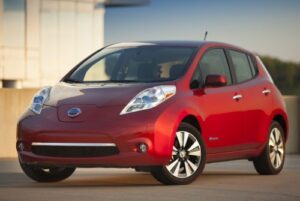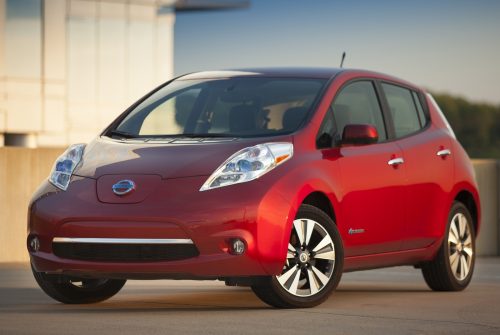
Recently I bought a fully electric powered car, second hand. It’s a 24kwh, Nissan Leaf Tekna with a 2015 number plate approaching 28k mileage, bought from a dealer for £9.5k (plus an ‘admin fee’, which I later found out was optional, bah!).
It was £700 off in a clearance sale which seemed genuine – it looks like it had been sitting around in the dealer for 8 months. This is a concern as if a electric car battery is on high charge, having it sitting around unused can be a bad thing, and general car dealers might well not know this.
The car was listed as having an onboard 3.3kw charger, but it has the expensive option of a 6.6kw charger, which allows it to be charged twice as fast on middling kinds of chargers. It’s apparently quite common for dealers to not know what they’re selling, and in this case I think it made the car a reasonable deal.
There are scare stories of having to replace the main car battery every five years, I think thanks to rumours spread by Top Gear (a UK entertainment show that pretends to be about cars). The battery on this one is completely fine, with the dash showing the maximum of 12 bars of battery health, despite approaching its fifth birthday. It is possible for dealers to reset this so you have to be careful, but it’s stayed at 12 so I think it’s good. You can get more detailed information by plugging in an ‘OBD-II dongle’ and reading data off the battery management system using an Android app. However despite buying two different dongles (a wifi and a bluetooth one) I still haven’t got this working..
[Update: I got the bluetooth dongle working finally, not sure what was wrong.. It’s showing 91.4% state of health, not bad!]
Driving range is heavily dependent on driving style and weather – you get to drive further on a single charge in summer, but it seems I can comfortably get 60 miles at the moment and still have 10-20 miles range on reserve for peace of mind. You need this because sometimes public chargers are out of action, or “ICEd” – occupied by a fossil fuel-driven car (ICE = internal combustion engine) using a charging spot as a parking space. There’s a lot of discussion about the people who do this (sometimes known as ICEholes) on the forums.
There’s also a lot of misinformation on the forums. If you do get a OBD-II dongle working you can get an accurate-looking percentage about battery state of health, and this goes up if you do a ‘rapid charge’. But in truth, the state of health number is a guess, and it seems that doing too many rapid charges are actually bad for your battery health. At least this article seems fairly evidence based, and instead says that resting your battery on low charge seems to help it recover.
So what does it feel like to drive? After my old ford fiesta, it’s absolutely amazing. It’s super quiet, which means it’s really great for listening to music (on the bose 2.1 system). It has heated seats and steering wheel (this is amazing, and also much more efficient than the main heating system, which shaves some miles off the range). Plus 360 camera for parking (top-down, early grand theft auto style), and so on.. I learned to drive late in life, but hired a lot of cars in the past and have never really enjoyed driving at all before. I’d still much prefer a nice train journey for longer distance, but this is actually not bad.
EV drivers talk about ‘range anxiety’, and it is real. The longest drive I did so far was to the arcade club in Leeds, which happened to have free vend EV charge spaces. Thanks to the 6.6kw charger it was fully charged during our 2-3 hour visit, ready for the return journey. That was a ‘destination charger’ on ‘fast charge’. At home I’ve been using trickle charge off a standard 3 pin plug, which takes longer but charges fully overnight (I’ve ordered a podpoint which will allow the full 6.6kw charge at home). We’re planning a longer trip to the south coast which will need a few charges on the way.. This is where those rapid charges come in, in my old 24kwh model (newer Leafs are up to 64kwh) this means stopping around every 50-60 miles to charge up for 20 minutes or so. You basically have to stop for X minutes in order to go X miles, so it doesn’t really take you any longer to stop more often, as long as the chargers are all on your route. For battery chemistry reasons you can only rapid charge up to 80%, then it goes slow enough to not be worth waiting around for.. Which means your first leg from 100% can be a bit longer, and you can probably get back up to 100% over lunch.. Lets see how that goes.
[Update: just did a drive from Sheffield to Manchester, didn’t quite have the charge for the return journey, and had a stressful half hour or so finding a spare place to charge.. Took a few attempts in city centre traffic, but got a (free!) charge in the end. Not convenient though, I should have just parked up anywhere and got a rapid charge on the motorway on the way home, or just taken the train..]
Running costs are super low. Without an ICE, there’s not much to go wrong, and these cars have proved reliable. ‘Fuel’ is often free, or at worst several times cheaper than petrol/diesel. There’s no vehicle tax (for now), and on-street parking and all the council car parks in Sheffield is free (you have to register first). If/when EV sales take off, this is all subject to change.. But electricity will always be cheaper than petrol.
In terms of local air pollution, they’re great. Brake pads are hardly used (the energy goes back into the battery via a generator), cutting down on airborne fine particulates. You tend to drive more smoothly to conserve energy, which I naively guess means less tyre wear in the air. Plus of course, there’s no exhaust. We use green energy at home (good energy), and the chargers tend to run off green energy too. (I realise it all comes via the national grid, but please save me that argument..)
In terms of impact on the climate, things are less clear. The impact of manufacturing a car and battery is very high. Probably better than a ‘conventional’ ICE, and they seem to be lasting longer too, but hey. EVs are not The Answer. But still, at least when you drive them you’re not contributing to illegal and extremely dangerous levels of local air pollution.
That said, electricity companies are currently experimenting with using EVs for energy storage. All those batteries could really help solve how to smooth out renewable but intermittent energy from wind and solar. They’re testing whether they can do this without causing early battery degradation. Definitely plausible.
In privacy terms it’s a bit of a disaster.. I didn’t have to sign up with Nissan, but now I have, they seem to know where my car is at all times. On the plus side so do I, and I can check its charge remotely, and get loads of stats and stuff.
Anyway, it seems good overall. Eventually the battery will show degradation, but nonetheless I have a feeling now is a good time to buy second hand. Electric motors don’t wear like combustion engines, and third parties are starting to replace EV batteries with new ones of higher capacity than the originals. EV batteries are currently made with limited materials such as cobalt, so it’s not guaranteed that they’ll get cheaper.. But maybe technology will soon advance to the point where we work around these dependencies, and I’ll be able to swap in a new one for relatively little. That glosses over the conflict and pollution around battery manufacture, but again, that probably works out considerably better than oil..
